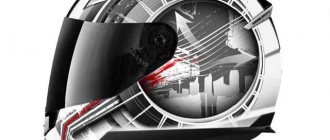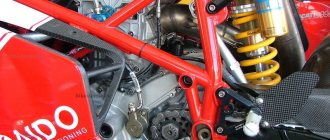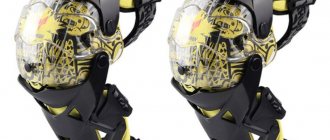A helmet is a necessary means of protection when riding motorcycles. If it is missing, you will be subject to an administrative fine. In addition, it protects the motorcyclist from headwinds, insects, stones, dust, even an open motorcycle helmet. Therefore, when purchasing, you should pay attention specifically to the safety factor, and only then to the appearance and beautiful design.
There are different types of motorcycle helmets depending on the size, clasp, material, shape. Of course, the general requirements for all headgear are the same: the helmet must be easy to remove, provide visibility, and be comfortable when moving.
Types of helmets
Motorcycle helmets vary significantly and for each class of equipment there are preferred types.
Integral (full face)
Integral
The most versatile, reliable and simple option suitable for most motorcycle classes.
With this full-face helmet you can provide the maximum level of protection as it completely covers your head. The protective glass is equipped with a folding mechanism. Its main feature is reliable protection of the chin, damage to which occurs in 35% of road accidents. The purpose of the safety strap is to hold the helmet on your head in the event of an accident. This type of protection is ideal for those who like to drive fast.
Among the main advantages are:
- excellent protection;
- excellent level of aerodynamic performance;
- excellent sound insulation;
- protection from bright sun, dust, wind and adverse weather conditions;
- the ability to choose a design that suits a specific image.
Flaws:
- poor ventilation, you just want to tilt your chin into the traffic jam;
- the need to take off to drink and eat;
- Inconvenient to use with prescription glasses and sunglasses.
Modular (flip-up)
Modular
This type is an improved integral, characterized by greater practicality and versatility. The helmet completely covers the head. The internal filling is the same as the previous one, but there is a significant difference, namely: weight, sun visor and a special design of the chin part, which is movable thanks to the hinge joint. Such a chin bar in a helmet makes the life of a motorcyclist much easier - he can drink water, smoke or talk to others without removing his helmet. The opening function is controlled by a special button that is protected from accidental pressing. This model is most popular among long-distance motorcyclists.
The main advantages of modular include:
- excellent aerodynamics;
- high degree of protection;
- convenience and comfort in use;
- good sound insulation (compared to open helmets);
- the ability to tilt up the protective glass and chin;
- possibility of attaching an intercom or headset.
- convenient to use with glasses
The disadvantages are considered:
- higher cost;
- insufficient ventilation;
- the heaviest weight among helmets;
- lower aerodynamics than the integral;
- noise (depending on quality);
- fragility (due to a more complex device)
Open helmet
open helmet (3-quarter)
This model does not have a chin bar, so the helmet protection system cannot be called reliable. In addition, the presence of protective glass is optional.
Due to the low protection of the driver, the helmet is not recommended for fast driving. Most suitable for a scooter or motorcycle, which is characterized by a small cubic capacity.
Despite this, the open helmet has the following advantages:
- the ability to provide maximum visibility;
- excellent level of ventilation;
- freedom of movement;
- light weight;
- affordable price.
- Convenient to use with various glasses and masks
Based on how much the head is covered, there are: a half-helmet (the lightest model) and a three-quarter or bowler hat.
3-quarters are preferred by scooterists, and half is the favorite helmet of brutal chopper riders.
Cross motorcycle helmet
This type of helmet was developed specifically for cross-country racing. A distinctive feature is the presence of a chin arch, slightly pushed forward, which is necessary to facilitate breathing. The purpose of the long visor present is to protect against stones flying out from under the wheels. This helmet is not equipped with a protective visor, so the driver must combine it with glasses or a protective mask.
The advantages include:
- good level of visibility;
- excellent ventilation;
- protection from sun and rain provided by the visor.
The disadvantage of the helmet is the aerodynamic pressure on the head at high speeds. After 100kmh it is almost impossible to keep your head up. Therefore, they are used primarily for mud mixing and hauling around the city.
Types of helmets
Choose the best option for yourself:
"Integral"
The most popular helmet among motorcyclists is the “integral” helmet. It has a completely closed structure. It perfectly protects the head, has an excellent level of sound insulation, fairly acceptable aerodynamic resistance, and perfectly prevents the entry of wind, rain, dust, and various annoying insects that often annoy motorcyclists at high speed. But it still has many design flaws that affect its popularity. These motorcycle helmets are the heaviest among all others. As a result, it can be noted that in this motorcycle helmet you will be extremely hot. Although they have ventilation, this is a rather weak consolation - it helps motorcyclists very little.
Therefore, riding in such a helmet will not bring much pleasure. The most effective use for them will be sports motorcycles. After all, sporting events involve one of the highest levels of risk. Even in the photo you can see how massive the structure of such head protection is.





